
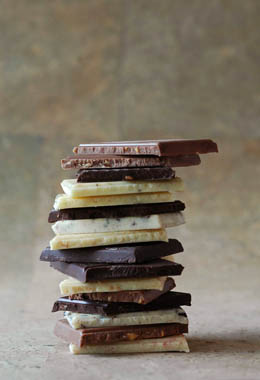
The number-one-selling chocolate bar in Switzerland, Frey, is now available at Target. Intensely flavorful—and a bargain—they scream to be tasted. All photography by Dhanraj Emanuel.
|
PETER ROT is the THE NIBBLE’s chocolate specialist.
|
October 2007
|
 |
Frey Chocolate
Venerable Swiss Chocolate Bars Come To America
EDITOR’S NOTE 2010:
This review was written in 2007. The line is no longer carried by Target. When we last checked in July 2010, Frey had changed its website and
removed the “Contact Us” link; but you can keep checking to see if they restore it.
|
CAPSULE REPORT: In 1875, Daniel Peter of Vevey, Switzerland invented milk chocolate. In 1879, Rodolphe Lindt of Berne invented conching, which replaced the then-grainy chocolate with silky, smooth bars. In 1887 the Frey brothers established a chocolate company and quickly became known for their bars, now available in the U.S., combining classic Swiss chocolate styles with some cutting edge products. The bars can be found in Target stores nationwide, popularly priced.
When most people think of Swiss chocolate, a predictable motif invariably springs to mind: the snowcapped Swiss Alps towering over a stretch of sloping green hills, grazing cows and smiling milkmaids. This bucolic scene demands a national specialty in milk chocolate—and in fact, all those cows giving fresh milk had to have something to do with the Swiss fascination with milk chocolate. More scientific, though, the contribution of the Swiss to the advancement of chocolate during the Industrial Revolution. A Brit may have invented the chocolate bar, a Dutchman, cocoa, and a Belgian, molded chocolates, but Swiss chocolatiers invented milk chocolate, white chocolate, fondant, filled chocolates and the silky smooth chocolate we know today.
The chocolate bar was invented in 1847 (prior to then, chocolate was drunk as a beverage—hot chocolate). During the late 1800s, European chocolate makers were determined to combine milk and chocolate into a solid bar. All attempts had ended in failure, because milk at the time contained too much moisture to yield a firm, solid product. However, in 1875, chocolate maker Daniel Peter of Vevey, Switzerland achieved success when he used his neighbor Henri Nestlé’s newly-invented product, condensed milk. By substituting condensed milk for the milk and cream that had been previously tried by many, he created the world’s first stable milk chocolate bar.
An even bigger step in chocolate history was taken by Rodolphe Lindt, a chocolate manufacturer in Berne, who in 1879 invented the conching machine. Before this invention, chocolate was rough and grainy, bearing no resemblance to the smooth and silky textures we enjoy today. While Daniel Peter experimented for years, the story goes that Lindt went hunting for the weekend and failed to turn off a chocolate processing machine; he returned to the discovery that excessive churning (conching is named for the shape of the paddle, which looked like a conch shell) created a refined and velvety chocolate. Lindt also discovered that adding cocoa butter to the conch, while the cocoa liquor was refining, made the finished chocolate more malleable and less bitter. This allowed for the manufacture of couverture or coating chocolate, supple enough to coat other candies—fruit, nuts, caramels, marshmallows, cream centers, etc.
With these two innovations, the manufacture of solid milk chocolate bars, and the realization of smooth, silky chocolates were now possible. Several Swiss companies—including Cailler, Kohler and Suchard—capitalized on these breakthroughs, and helped to bring chocolate from the aristocrat’s home into the lives of the common man. Alexandre Cailler released a milk chocolate with a distinct yet desirable “barnyard” flavor; Philippe Suchard developed the hugely popular and still famous Milka bars (1901); Jean Tobler created the Toblerone (1907), chocolate-covered torrone (Italian nougat); and Robert and Max Frey began to manufacture milk chocolate bars, ultimately launching the Giandor line.
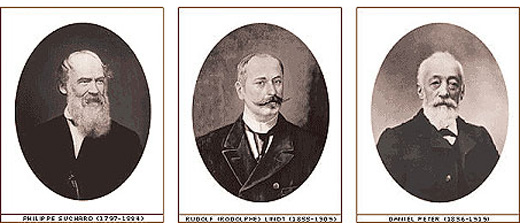 |
| From left to right: Philippe Suchard, Rodolphe Lindt and Daniel Peter. |
Each of these chocolates quickly became their company’s flagship product, leading to fame and success—not to mention the beginnings of a national chocolate empire centered on smooth and creamy milk chocolate. The novelty and newness of these chocolate creations no doubt played a significant role in their success, but the fact that many of these products can still be found in stores 100 or more years later is a testament to the long-lasting appeal of the original recipes.
Compared to Belgian- and French-style chocolate, Swiss-style chocolate is based on its innovations. It is the most creamy, smooth, soft and velvety, and has a greater focus on milk chocolate. And—back to those bucolic alpine meadows—the quality of the milk used in Swiss chocolate, which comes from cows that feed on grasses that are verdant from the runoff of mountain snows, contributes its own creaminess.
Chocolat Frey
Beginning in 1887 as a small family business in the town of Aargau, capital of the canton of Aargau in the north central section of Switzerland, the Frey brothers, Robert and Max, produced a simple milk 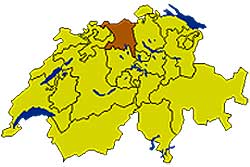 chocolate tablet (the French word for bar) that was met with great success, along with cocoa powder. The still-popular Giandor bars were introduced between 1930 and 1940. Like many of of the chocolate entrepreneurs, Frey expanded its operations to meet growing demand. In 1950 the company joined with Swiss retail giant Migros Group and is now Switzerland’s leading chocolate brand, capturing nearly 40% of the country’s retail market sales. (Toblerone and Milka are now owned by Kraft.) Of the major Swiss brands, only Frey is produced completely in Switzerland from (presumably) that good Alpine milk‡; the others have worldwide production facilities. chocolate tablet (the French word for bar) that was met with great success, along with cocoa powder. The still-popular Giandor bars were introduced between 1930 and 1940. Like many of of the chocolate entrepreneurs, Frey expanded its operations to meet growing demand. In 1950 the company joined with Swiss retail giant Migros Group and is now Switzerland’s leading chocolate brand, capturing nearly 40% of the country’s retail market sales. (Toblerone and Milka are now owned by Kraft.) Of the major Swiss brands, only Frey is produced completely in Switzerland from (presumably) that good Alpine milk‡; the others have worldwide production facilities.
‡Felchlin, the connoisseur brand for eating and baking, is also produced completely in Switzerland.
Until recently, though, Chocolat Frey has been limited only to European outlets and to foreign travelers who brought bars home to enjoy. This year, the company decided to embrace the pioneering fortitude of their Swiss founders, and introduced the product line to North America.
Frey chocolate has evolved since 1887. Even the original milk chocolate Giandor bar, a gianduja-like bar made with almonds, has been revamped, and is now available in dark and white chocolate versions as well as milk. But more of a departure, Chocolat Frey has branched out with extensive line of chocolate bars, each infused with distinct and entertaining flavors—some of which were developed with input from American consumers. The bars can be found in Target stores nationwide, for very affordable prices.
For $1.99 a bar or less, Frey is not Felchlin, Switzerland’s greatest chocolate, or even Lindt in terms of sophistication. However, it will appeal to many people, and some of the flavors are quite charming. The bars make nice gifts for people who are just beginning to trade up from newsstand chocolate, or who like cutting edge flavors (try the White Lemon & Lime. It's a good alternative to what’s available now at its price point, and Frey has done a great job by developing flavors that keep things fresh, lively and entertaining.). It’s a good sign to see an old-line chocolate company moving forward with extreme chocolate and other progressive flavors. New to the U.S., Frey offers great novelty and appeal that Hershey and Lindt can’t right now. I’m sure Frey will easily find a niche here.
Frey Style
Frey (the name is pronounced fray, not fry) is no sleepy Swiss chocolate or chain store also-ran. It’s no remnant of the 19th century. It’s a happening bar. Frey is:
Potent. When biting into a bar, the first thing you might notice is the potency and intensity of each flavor. They don’t whisper—they scream, some at almost deafening volumes. We liked these intensity levels—they were a refreshing spark among so many of the subtle and downplayed bars on the market.
Fudgy. The second thing you’ll notice is texture. The texture for the milk and white bars is thicker and more fudge-like in consistency than other bars you may come across.* Mix-ins add textural appeal, whether it’s a resounding crunch through any of the various citrus powders or cookie crumbs, or a softer thud from nuts or cacao nibs. Dark chocolate bars tend to be firmer and melt with a smoother body, just as you would expect from dark chocolate.
*The proteins found in milk contribute a softer, thicker texture to a finished bar of milk chocolate, especially in lower percentage cacao bars. However, the higher the cacao content of the bar, the creamier the consistency will be, because the texture will rely more heavily on the cocoa solids than the milk solids. |
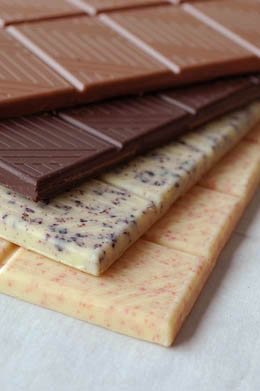
Frey’s rainbow of chocolate bars: the milk chocolate Japonais with hazelnut filling and the fiery dark chocolate Hot Chilli Pepper, both favorites, along the more extreme, candy-crossed Cinnamon & Blood Orange and White Blueberry. |
Personable. You might find that each bar has its own distinct personality. For example, there was a playful charm to Citron & Poivre (Citrus & Pepper) and White Blueberry, while Café & Cacao and Tiramisu possessed a much more serious edge. Hot Chilli Pepper is downright feisty, while Bouquet d’Oranges is calm and relaxing.
Although the bars do contain a few questionable† ingredients, such as vegetable oils and artificial flavors, we just can’t help ourselves to what Frey has concocted. We also have to commend them for their experimental spirit in a country usually known for a more conservative and neutral position.
†i.e., these are product ingredients used in mass-manufactured bars rather than the gourmet chocolate we usually write about. However, in fairness, Chocolat Frey is priced at one-third to one-fifth of those “gourmet” bars.
Frey Chocolate Varieties
This review covers the entire range of bars available in the United States. We weren’t able to obtain three of the six Special Swiss Reserve bars (Noir Satin, Noir Authentique and Merveille de Lait), but we hope to include them at a later date. The milk and white bars have a cacao content of roughly 31%,‡ while the dark bars are 55% cacao. It’s curious that some flavors are titled in English while others are in French, but that may evolve over time: Frey is newly exporting its bars to America. While we have reviewed the flavored bars here, Frey also exports its plain milk and dark chocolate bars.
‡While the astute will note that there is no cacao, or cocoa solids, in white chocolate, the term when applied to white chocolate refers to the percentage of cocoa butter.
White Chocolate
This is a group of unusual flavors and texture: candy combined with white chocolate. It’s adult chocolate, but kids will love it.
Cinnamon & Blood Orange. This is a weird and unusual bar. The flavor of Cinnamon Red Hots candies is captured almost identically here, with a subtle touch of blood orange underneath to add a hint of fruitiness and minor tartness. The overall combination can be jarring and shocking because of the strength of the cinnamon. It is extreme chocolate. We’re sure there are takers: If your idea of confection perfection is a chocolate bar crossed with Red Hots, then take it away!
Rhubarb & Aloe Vera. This is the most sophisticated of the white bars, and the one that children are least likely to appreciate. The nice, milky white chocolate base (we’d love a plain white chocolate Frey bar) is sprinkled with aloe vera powder, which adds texture, crunch and visual appeal. For those who have never eaten aloe vera but only enjoyed it in moisturizers, it tastes herbal (no surprise there)—like the herbs in a Ricola drop without the menthol. The juxtaposition of sweet chocolate with crunchy herbs is quite unique and interesting. Those who enjoy quinine water and mineral flavors should enjoy this bar as well.
|
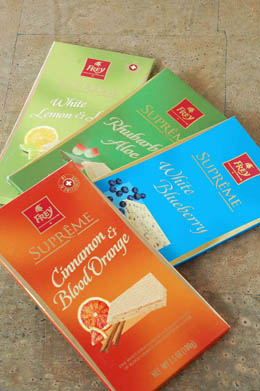
Frey’s white chocolate group. |
White Blueberry. Prepare for blueberry overload! The blueberries are almost candy-like in their flavor—they even add a candy crunch when the chocolate is chewed. This is one of the sweeter bars, a lighthearted chocolate that will also appeal to kids. Adults may enjoy one small piece at a time.
White Lemon & Lime. If you like sour candy, this bar is for you. The white chocolate is populated with chips of tart Key lime candy. A true sweet-n-tart experience for grown-ups, the pucker of the lime candy is balanced with the smooth white chocolate.
Milk Chocolate
What about the milk chocolate—where it all began? There’s no Giandor in the U.S., but there’s plenty of excitement so that no one will miss it.
Café & Cacao. A base of sweet milk chocolate has been fortified by coffee and cacao nibs. The result is a classic combination of coffee and chocolate that turns out to be one of the more successful of Frey’s bars, and one that adds textural dimension on top of the already multifaceted flavor.
Coeur de Macadamia. Macadamia nuts don’t necessarily possess a strong or pronounced flavor, but hazelnuts on the other hand do. So when combined, we pretty much know which one will be dominant. Having said that, the flavor of the bar is more or less similar to a hazelnut milk chocolate, and it’s just as delicious as you would expect. We would have liked the macadamia nuts to be the star player, but we’ll happily take the bar as it is, though.
Japonais. The cookie displayed on the package front clues you in that this bar combines a hazelnut filling with crunchy cookie bits, encapsulated by a milk chocolate exterior. The experience is similar to eating Nutella slathered on a piece of toast, which in our books brings no complaint (except when the was no more). |
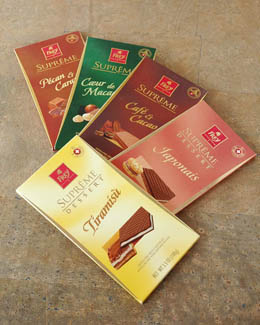
Frey Chocolate’s flavored milk bars. |
Pécan & Caramel. The overall flavor of this bar wasn’t as similar to caramel as we were expecting. The dried cream, however, adds a richer quality than the nutrition label indicates, as well as a distinct dairy sweetness not common with the other milk bars. It’s a good bar with a nice but low-key nutty flavor.
Tiramisu. This bar is much heavier and richer than it looks—just like the dessert it’s named after. We could only eat a few squares before satiety set in. The center is based on mascarpone, flavored with coffee. Frey captured the flavor of tiramisu valiantly. Now, tiramisu lovers can have a dish of the pudding with a Frey bar chaser.
Dark Chocolate
We’re dark chocolate lovers at heart, so were interested to see how a company with a milk chocolate heritage evolved in this area.
Coeur de Macadamia. Macadamia nuts don’t necessarily possess a strong or pronounced flavor, but hazelnuts on the other hand do. So when combined, we pretty much know which one will be dominant. Having said that, the flavor of the bar is more or less similar to a hazelnut milk chocolate, and it’s just as delicious as you would expect. We would have liked the macadamia nuts to be the star player, but we’ll happily take the bar as it is, though.
Bouquet d’Oranges. Chocolate and orange is one of the more familiar flavors at retail, and it’s no surprise that it’s one of the best sellers in the line. Surprisingly for just 55% cacao—a mere step over the line from milk chocolate into semisweet—the dark chocolate is substantially strong and provides a background that enhances the orange. This “comfort flavor” is all-around cozy and reliable, neither too sweet nor too strong. Perfect for day-long munching. |

Frey Chocolate’s flavored dark bars—55% cacao. |
Citron & Poivre. Lemon jolts the senses and even adds textural appeal, since its cheerful and charismatic flavor is present in the form of a powder which lends an occasional crunch. Pepper contributes a subtle but effective kick in the back of the throat after each bite is gone, serving as a reminder that this chocolate is not as playful as the lemon flavor suggests.
Hot Chilli Pepper. You might need a glass of milk for this one. Pieces of dried chile have been added to the bar, which results in a fiery but pleasant sensation that ignites the entire mouth. As hot as the bar may be, though, the chocolate does a good job at mediating the heat, and it’s certainly stronger than expected for a 55%. Against the chile and heat, the flavor of the chocolate can be tasted easily, lending additional depth to the bar in the form of an ashy and woody flavor.
Have you had enough chocolate? Hopefully today you’ve learned a little about Swiss chocolate, and are motivated to taste the chocolates of Frey. Also check out our review of Lindt chocolate bars, made by the Frey brothers’ early colleague (and without whom they would not have been able to make such silky-smooth chocolate bars), Rodolphe Lindt.
CHOCOLAT FREY
Swiss Chocolate
- Assorted Bars
3.5 Ounces Per Bar
$1.99
Purchase at Target stores
The products are not currently online at Target.com.
Prices and flavor availability are verified at publication but are subject to change.
For more information about chocolate, including a glossary of chocolate terms and how to identify the aromas and flavors of chocolate, visit the main page of our Chocolate Section. |
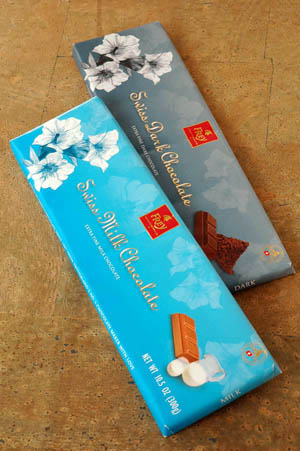
Frey’s plain milk and dark chocolate bars.
|
Lifestyle Direct, Inc. All rights reserved. Images are the copyright of their respective owners.

|






 chocolate tablet (the French word for bar) that was met with great success, along with cocoa powder. The still-popular Giandor bars were introduced between 1930 and 1940. Like many of of the chocolate entrepreneurs, Frey expanded its operations to meet growing demand. In 1950 the company joined with Swiss retail giant Migros Group and is now Switzerland’s leading chocolate brand, capturing nearly 40% of the country’s retail market sales. (Toblerone and Milka are now owned by Kraft.) Of the major Swiss brands, only Frey is produced completely in Switzerland from (presumably) that good Alpine milk‡; the others have worldwide production facilities.
chocolate tablet (the French word for bar) that was met with great success, along with cocoa powder. The still-popular Giandor bars were introduced between 1930 and 1940. Like many of of the chocolate entrepreneurs, Frey expanded its operations to meet growing demand. In 1950 the company joined with Swiss retail giant Migros Group and is now Switzerland’s leading chocolate brand, capturing nearly 40% of the country’s retail market sales. (Toblerone and Milka are now owned by Kraft.) Of the major Swiss brands, only Frey is produced completely in Switzerland from (presumably) that good Alpine milk‡; the others have worldwide production facilities. 



